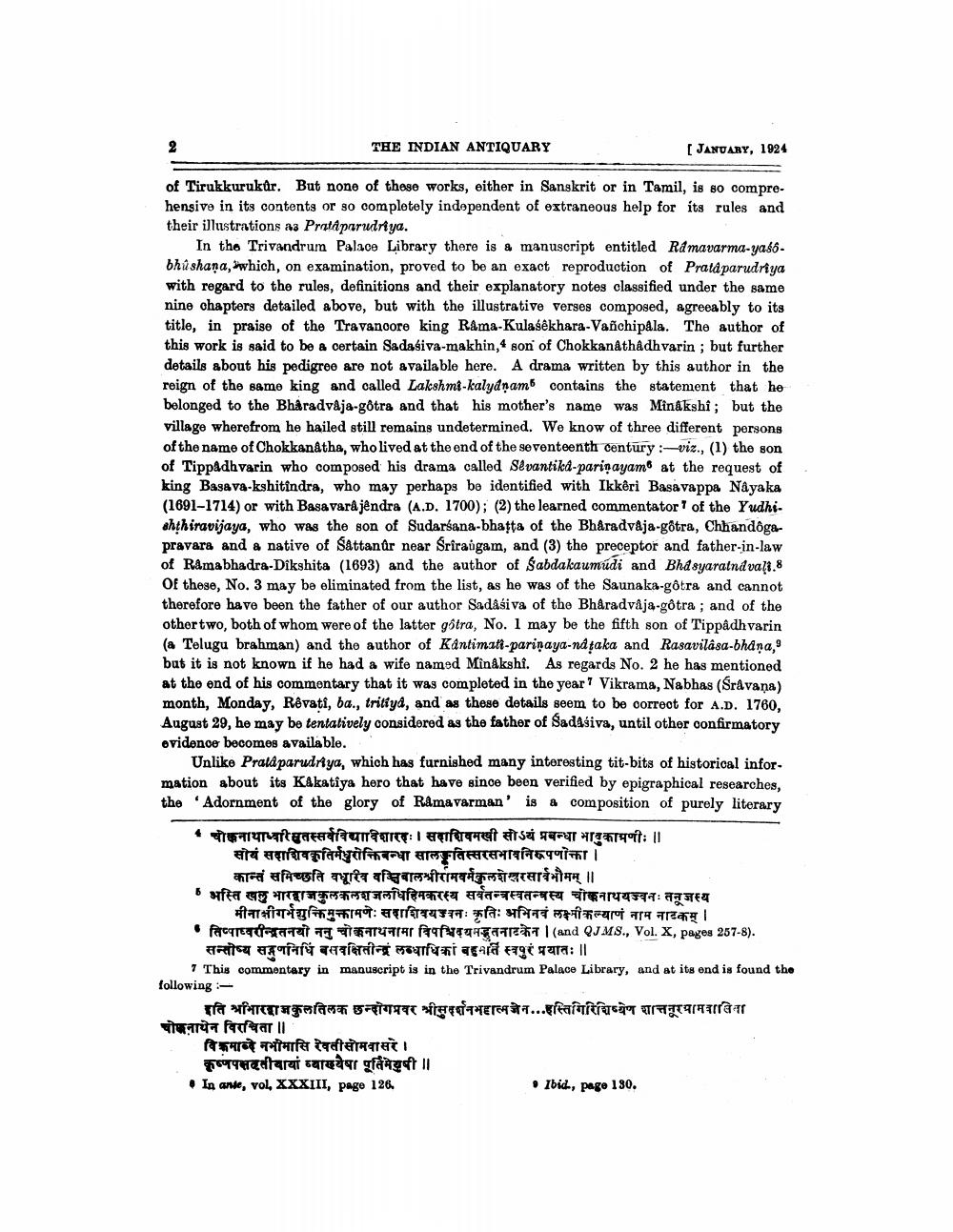Book Title: Indian Antiquary Vol 53 Author(s): Richard Carnac Temple, Stephen Meredyth Edwardes, Krishnaswami Aiyangar Publisher: Swati Publications View full book textPage 8
________________ 2 THE INDIAN ANTIQUARY [ JANUARY, 1924 of Tirukkurukûr. But none of these works, either in Sanskrit or in Tamil, is so comprehensive in its contents or so completely independent of extraneous help for its rules and their illustrations as Prataparudrtya. In the Trivandrum Palace Library there is a manuscript entitled Ramavarma-yaśôbhushana, which, on examination, proved to be an exact reproduction of Prataparudriya with regard to the rules, definitions and their explanatory notes classified under the same nine chapters detailed above, but with the illustrative verses composed, agreeably to its title, in praise of the Travancore king Rama-Kulasekhara-Vañchipala. The author of this work is said to be a certain Sadasiva-makhin, son of Chokkanathâdhvarin; but further details about his pedigree are not available here. A drama written by this author in the reign of the same king and called Lakshmi-kalyanam contains the statement that he belonged to the Bharadvaja-gôtra and that his mother's name was Minakshi; but the village wherefrom he hailed still remains undetermined. We know of three different persons of the name of Chokkanatha, who lived at the end of the seventeenth century:-viz., (1) the son of Tippadhvarin who composed his drama called Sevantika-parinayam at the request of king Basava-kshitindra, who may perhaps be identified with Ikkêri Basavappa Nayaka (1691-1714) or with Basavarajendra (A.D. 1700); (2) the learned commentator of the Yudhishthiravijaya, who was the son of Sudarsana-bhatta of the Bharadvaja-götra, Chhandôgapravara and a native of Sâttanûr near Srirangam, and (3) the preceptor and father-in-law of Ramabhadra-Dikshita (1693) and the author of Sabdakaumudi and Bhasyaratna vali.8 Of these, No. 3 may be eliminated from the list, as he was of the Saunaka-gôtra and cannot therefore have been the father of our author Sadasiva of the Bharadvaja-gôtra; and of the other two, both of whom were of the latter gôtra, No. 1 may be the fifth son of Tippâdhvarin (a Telugu brahman) and the author of Kantimati-parinaya-nataka and Rasavilâsa-bhāņa, but it is not known if he had a wife named Minakshi. As regards No. 2 he has mentioned at the end of his commentary that it was completed in the year Vikrama, Nabhas (Śravana) month, Monday, Rêvați, ba., tritiyâ, and as these details seem to be correct for A.D. 1760, August 29, he may be tentatively considered as the father of Sadasiva, until other confirmatory evidence becomes available. Unlike Prataparudriya, which has furnished many interesting tit-bits of historical information about its Kakatiya hero that have since been verified by epigraphical researches, the Adornment of the glory of Ramavarman' is a composition of purely literary * चोक्कनाथाभ्वरितस्सर्वविद्याविशारदः । सदाशिवमखी सोऽयं प्रबन्धा भावुकामणीः || सोयं सदाशिवकृतिर्मधुरोक्तिबन्धा सालङ्कृतिस्सरसभावनिरूपणोक्ता । कान्तं समिच्छति वधूरिव वचिवालश्रीरामवर्मकुलशेखर सार्वभौमम् || 5 अस्ति खलु भारद्वाज कुलकलशजलधिहिमकरस्य सर्वतन्त्र स्वतन्त्रस्य चोकनाथयज्वनः तनूजस्थ मीनाक्षीगर्भशुक्तिमुक्तामणेः सदाशिवयज्वनः कृतिः अभिनवं लक्ष्मीकल्याणं नाम नाटकम् | • तिप्पाष्वन्द्रितनयो ननु चोक्कनाथनामा विपश्चिदयमद्भुतनाटकेन | (and QJMS, Vol. X, pages 257-8). सन्तोष्य सद्गुणनिधिं बसवक्षितीन्द्रं लब्धाधिकां बहुना स्वपुरं प्रयातः || 7 This commentary in manuscript is in the Trivandrum Palace Library, and at its end is found the following इतिश्रीभारद्वाज कुलविन्दर श्रीमहाल जेन...हस्तगिरिशिष्येष शान्तनुरपामवासिना चोकनायेन विरचिता ॥ विक्रमाब्दे नभोमासि रेवती सोमवासरे । pwvezdarai særuder glänge? || In ante, vol, XXXIII, page 126. Ibid., page 130.Page Navigation
1 ... 6 7 8 9 10 11 12 13 14 15 16 17 18 19 20 21 22 23 24 25 26 27 28 29 30 31 32 33 34 35 36 37 38 39 40 41 42 43 44 45 46 47 48 49 50 51 52 53 54 55 56 57 58 59 60 61 62 63 64 65 66 67 68 69 70 71 72 73 74 75 76 77 78 79 80 81 82 ... 392
